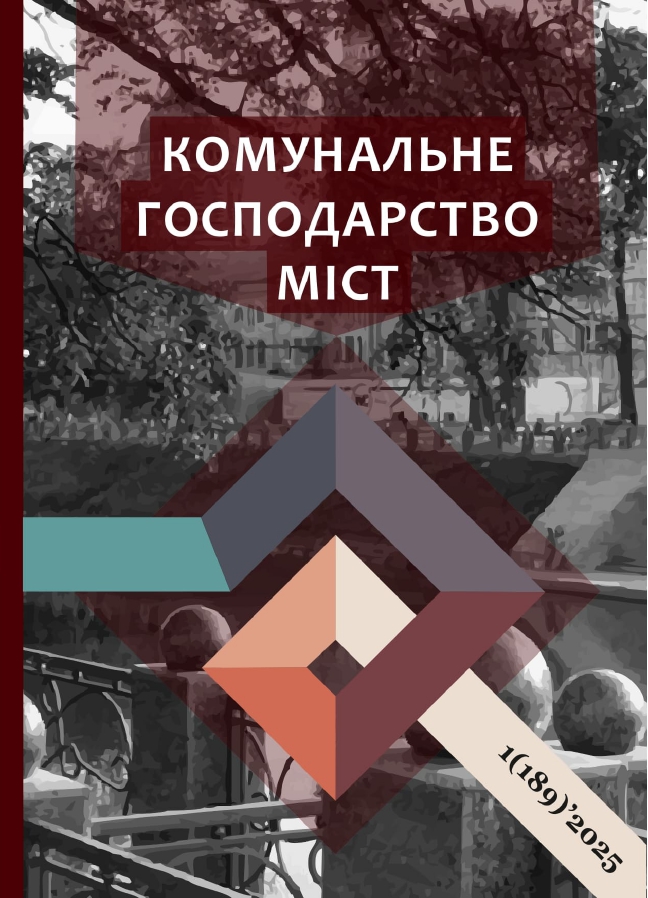TERMINOLOGICAL CONNOTATIONS OF VISIONARY ARCHITECTURE. UTOPIAN, FANTASTIC AND FUTURISTIC
DOI:
https://doi.org/10.33042/2522-1809-2025-1-189-86-91Keywords:
visionary architecture, utopianism, fantasy, futurism, erminology, architectureAbstract
Dictionaries, glossaries, and studies that outline the conceptual definition of the term «Visionary Architecture» demonstrate a discrepancy in the information provided, so the concepts of utopian, fantastic, and futuristic architecture are often considered synonymous with it.
The aim of research is to identify and systematize data on the concept of «Visionary Architecture» and its terminological connotations, outlined by the concepts of utopianism, fantasy and futurism as the most common; to determine their interconnection for enrichment and deeper disclosure of professional architectural terminology.
The scientific paper explores utopianism, fantasy, and futurism as terminological connotations – accompanying meanings – of visionary architecture, highlighting the unique relationships between them. Utopianism is most closely aligned with visionary architecture due to its pursuit of grasping the vast and transcending reality in search of an idealized conception. This aligns with the aspirations of visionary architects, who often supported their bold ideas with solid theoretical and logical foundations. The connection between fantasy and visionary architecture lies in the ideological inspiration and daring design explorations, which may initially appear eccentric but have the potential to become a future reality. Futurism, closely tied to fantasy, reflects the unrealized ideas of the present that might materialize in the future, making it intrinsically linked to the legacy of visionary architecture. Architectural visions have always driven the pursuit of innovative design approaches. Even when they remain unrealized, existing only on paper or other media, they have a profound impact, inspiring and energizing the creative spirit of architects and designers.
Architectural visions have always driven the pursuit of innovative design approaches. Even when they remain unrealized, existing only on paper or other media, they have a profound impact, inspiring and energizing the creative spirit of designers. The term «Visionary Architecture» is reasonable due to the depth of its interpretive meaning. The word «visionary» refers to «one who sees», while «vision» signifies «sight» or «imagination». This term encompasses both the conceptualization of ideal city projects aimed at creating perfect living environments (utopian architecture) and the imagination of extraordinary megastructures of the future (fantastic and futuristic architecture). These diverse connotations enrich the realm of visionary architecture, highlighting its multifaceted nature and contributing to its rich project heritage.
References
Čerina, T., Jukic, T., & Cvitanović, M. (2022). Conceptual Definition of the Term Experimental Architecture: Ambiguity of Terminological Attributions. Prostor, 30, 168-177.
Kaminer, T. (2011). Architecture, Crisis and Resuscitation. Abingdon-on-Thames : Routledge, 216.
Thomsen, C. (1997). Visionary architecture from Babylon to Virtual reality. Munich : Prestel, 192.
Spiller, N. (2008). Visionary Architecture Blueprints of the Modern Imagination. London : Thames and Hudson, 271.
Singh, I.R. (2013). Utopia: An Interview with Reinhold Martin. Journal of Architectural Education, 67(1), 77-84.
Coleman, N. (2005). Utopias and architecture. Abingdon-on-Thames : Routledge, 352.
Schuyt, M., & Elfers, J. (1980). Fantastic Architecture: Personal and Eccentric Visions. New York : Abrams, 247.
Vostell, W., & Higgins, D. (1969). Fantastic Architecture. Lengerich : Kleins Druck- und Verlagsanstalt, 194.
Banham, R. (1960). Theory and Design in the First Machine Age. London : The architectural Press, 338.
Gambardella, C., Cennamo, C., Germanà, M.L., Shahidan, M.F., & Bougdah, H. (2019). Advances in Utopian Studies and Sacred Architecture. Cham : Springer, 368.
Ozarisoy, B., & Altan, H. (2023). Transgressive Design Strategies for Utopian Cities. Abingdon-on-Thames : Routledge, 268.
Walker, J. (1992). Glossary of Art, Architecture & Design Since 1945. London : Facet Publishing, 424.
Coulter, C.R., & Turner, P. (2020). Encyclopedia of Ancient Deities. Jefferson : McFarland, 605.
Curl, J.S., & Wilson, S. (2015). The Oxford Dictionary of Architecture. Oxford : Oxford University Press, 896.
Pevsner, N., Fleming, J., & Honour, H. (1966). Lexikon der Weltarchitektur 2.L-Z. Hamburg : Rowohlt Verlag, 642.
Visionary Architecture exhibition. Official website «Museum of Modern Art». Retrieved from https://www.moma.org/momaorg/shared/pdfs/docs/
press_archives/2734/releases/MOMA_1960_0132_108.pdf
Visionary Architecture. Official website «Kurt von Meier». Retrieved from https://www.kurtvonmeier.com/ visionary-architecture
Fissac, M.J. (1975). Arhitektonska utopija kao izvor stvaralaštva. Čovjek i prostor, 22.
Balasopoulous, A. (2004). Unworldly Worldliness: America and the Trajectories of Utopian Expansionism. Utopian Studies, 15(2), 3-35.
Blanco, J.R. (2016). Utopia. Introduction. Revista de Estudios Globales y Arte Contemporáneo, 4(1), 1-17.
Sagrada Familia completion date pushed back due to coronavirus. Official website «Building Design+Construction». Retrieved from https://www.bdcnetwork.com/home/news/55163668/sagrada-familia-completion-date-pushed-back-due-to-coronavirus
Curl, J.S. (2006). A Dictionary of Architecture and Landscape Architecture. Oxford : Oxford University Press, 912.
Watts Towers. Official website «Watts Towers Arts Center». Retrieved from https://www.wattstowers.us/ simon_rodia.htm
Banham, R. (1955). Sant’Elia. Architectural Review, 117(5), 295-302.
Banham, R. (1957). Futurism and modern architecture. The Journal of the Royal Institute of British Architects, 64(2), 129-138.
Downloads
Published
How to Cite
Issue
Section
License
The authors who publish in this collection agree with the following terms:
• The authors reserve the right to authorship of their work and give the magazine the right to first publish this work under the terms of license CC BY-NC-ND 4.0 (with the Designation of Authorship - Non-Commercial - Without Derivatives 4.0 International), which allows others to freely distribute the published work with a mandatory reference to the authors of the original work and the first publication of the work in this magazine.
• Authors have the right to make independent extra-exclusive work agreements in the form in which they were published by this magazine (for example, posting work in an electronic repository of an institution or publishing as part of a monograph), provided that the link to the first publication of the work in this journal is maintained. .
• Journal policy allows and encourages the publication of manuscripts on the Internet (for example, in institutions' repositories or on personal websites), both before the publication of this manuscript and during its editorial work, as it contributes to the emergence of productive scientific discussion and positively affects the efficiency and dynamics of the citation of the published work (see The Effect of Open Access).

